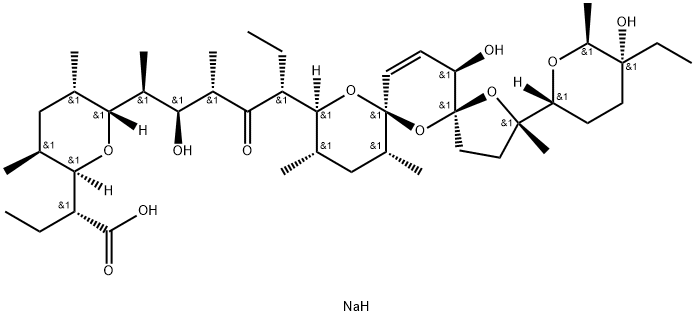| Identification | Back Directory | [Name]
Narasin | [CAS]
58331-17-2 | [Synonyms]
NARASIN
HainanMycin
Hainan drug
Narasin sodiuM
naransin sodium
Naracin sodium salt
Narasin (sodium salt)
4-MethylsalinoMycin sodiuM | [EINECS(EC#)]
1806241-263-5 | [Molecular Formula]
C43H71O11Na | [MDL Number]
MFCD06411262 | [MOL File]
58331-17-2.mol | [Molecular Weight]
789.04 |
| Hazard Information | Back Directory | [Uses]
Narasin sodium is prepared from narasin taking advantage of the carboxylic acid which ionises and readily forms the salt in sodium hydroxide solutions. Narasin is an ionophore with broad spectrum activity against Gram positive bacteria including anaerobes and mycoplasma, and also possesses antiviral and limited antifungal activity. Narasin is used in the animal health industry as an in-feed antibiotic and growth promotant. | [Uses]
Narasin sodium is prepared from narasin taking advantage of the carboxylic acid which ionises and readily forms the salt in sodium hydroxide solutions. Narasin shows broad spectrum activity against Gram positive bacteria including anaerobes and mycoplasma, and also possesses antiviral and limited antifungal activity. Narasin is used in the animal health industry as an in-feed antibiotic and growth promotant. | [Brand name]
Monteban (Lilly). | [Biological Activity]
narasin, isolated from certain streptomyces sp. is an ionophore antibiotic. as a coccidiostat, it can be used in veterinary practice for gastrointestinal parasites. narasin has been shown to induce tumor necrosis factor-related apoptosis-induced ligand (trail)-mediated apoptosis by er stress in glioma cells and to dampen nf-κb signaling by suppressing the phosphorylation of iκbα. nf-κb, as a transcription factor, plays a vital role across many cellular processes which are involved in neuronal and embryonic development, cell proliferation, apoptosis, and immune responses to infection and inflammation. | [in vitro]
narasin caused suicidal erythrocyte death or eryptosis. when human erythrocytes were exposed to narasin, it was shown that narasin resulted in the increase of annexin-v-binding indicating cell membrane scrambling with phosphatidylserine translocation to the erythrocyte surface and the decrease of forward scatter reflecting cell shrinkage, which indicated the death of erythrocyte [1]. narasin blocked nf-κb signaling via inhibition of iκbα phosphorylation at a lower concentration [2]. | [in vivo]
new zealand white rabbits were given narasin 4-48 p. p. m, in pelleted feed. after 4 weeks, the experiments indicated that narasin protected rabbits from severe coccidiosis induced by e. flavescens, e. perforans e. magna, e. intestinalis, and e. stiedai. in addition, narasin reduced oocyst output in a highly effective fashion [3]. | [IC 50]
3.2 μm: blocks nf-κb signaling via inhibition of iκbα phosphorylation | [References]
[1]. bouguerra, g., bissinger, r., abbes, s., & lang, f. stimulation of eryptosis by narasin. cellular physiology and biochemistry. 2015; 37(5):1807-1816.
[2]. miller, s., huang, r., sakamuru, s., shukla, s., attene-ramos, m., & shinn, p. et al. identification of known drugs that act as inhibitors of nf-κb signaling and their mechanism of action. biochemical pharmacology. 2010; 79(9): 1272-1280.
[3]. peeters, j., geeroms, r., antoine, o., mammerickx, m., & halen, p. efficacy of narasin against hepatic and intestinal coccidiosis in rabbits. parasitology. 1981; 83(02): 293-301. |
|
|





